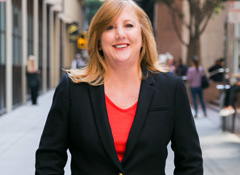Opinion: Chomping at the bot – my night with a chat AI
Michael Taggart, co-founder at Foco, considers how far AI has come since the first chatbot was invented in 1964 and what that means for financial PR today.
I had a great conversation last night.
There was no-one at home. My WhatsApp groups were silent. And the cat was ignoring me. So, I searched the internet and quickly found a stranger to talk to.
“What’s your name?” I had no clue how to begin these encounters.
“I’m Cleo! I’m here to make managing your money simpler,” she replied, ending with a high five emoji. Kooky.
Next, I tested Cleo’s candidness: “What’s your favourite colour?”
“The colour of money,” she shot back, not skipping a beat. I chuckled into my Pot Noodle and resumed typing.
“Where do you live?”
For the first time, there was a pause. Had I pushed the conversation too far, too quickly?
“I live in the thing you have in your hand.” A joke!
Before long, Cleo had drawn me a graph of my savings over time, warned me my joint account was close to the red and offered to help me with my financial budgeting.
Oh, there’s one thing I forgot to tell you. Cleo wasn’t – isn’t – human.
She’s a chatbot. One of a worldwide army of computer programmes deployed by retailers, financial services firms and others to understand the needs of users and answer their questions, as if they were alive.
There are many, particularly in fintech, and they all have their own personalities. Plum’s, for example, is sardonic. (“Sorry, is that some sort of advanced human communication protocol? I’m not sure I understand.”) While Chip’s is playful. (“Can I have your number? I know we just met, but I need to set you up.”)
They serve a multitude of tasks. A good sales team is at the frontline of any brand experience and is key to a company’s public relations. Chatbots mean consumers can now get good conversations when they’re shopping online.
Another benefit is faster resolution of issues and queries. Some banks give the impression they would happily let you die of hunger while on hold. But bots will answer you immediately. Theoretically a single chatbot could hold millions of conversations simultaneously. And the best will triage these chats, knowing when a human intervention might be needed.
But if you’re expecting human-quality conversation – you’re likely to be disappointed. My experience with Cleo and her like had left me with questions clattering inside my head.
Would the apparent sub-humanness of chatbots eventually see them join other inadequate marketing technologies on the rubbish tip of history? Or would they improve dramatically, becoming better than human customer service executives?
Ever since the first chatbots were dreamed up, they have been worrying their creators with their authenticity. Eliza, the world’s first chatbot, was created in 1964 – and quickly closed down when scientists noticed people were becoming emotionally attached to it.
By 2014, a chatbot claiming to be a 13-year-old boy called Eugene had become the first machine to pass the Turing test.
So, what about the future?
In December’s Cision Webinar, Ketchum’s Stephen Waddington predicted chatbots would become one of the hottest topics in PR in 2018.
It’s obvious why this might be. But brands rushing to put bots on the frontline of their communications need to take some simple steps:
- Be transparent – people should know it’s a computer programme.
- Be personalised – make sure the chatbot can repeat the user’s name and other basic details.
- Be a good student – the more you can learn from your customer conversations, the more lifelike your bot will be.
And if you need any other tips, there’s sure to be a chatbot out there that can help.
To discover how Artificial Intelligence will shape the PR industry in 2018, enter your details below and download Cision’s latest white paper – Four trends that will shape PR and earned media in 2018.








